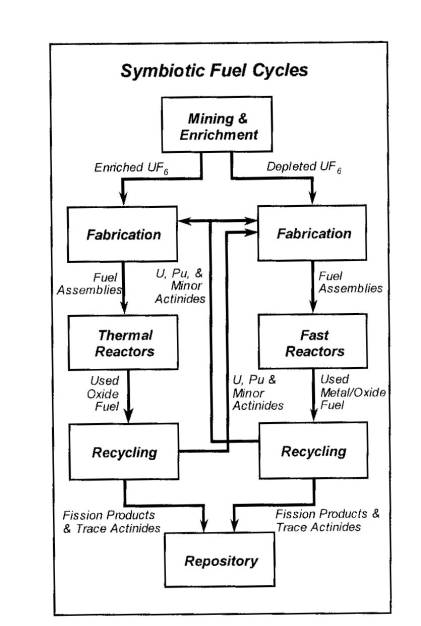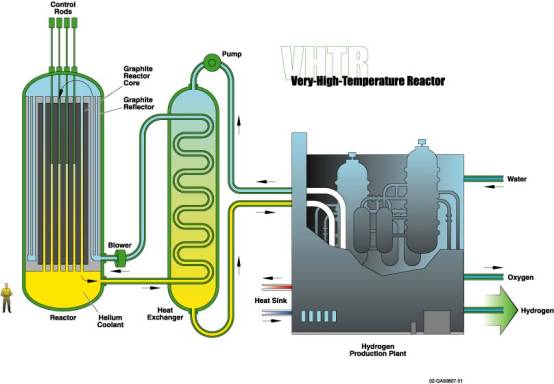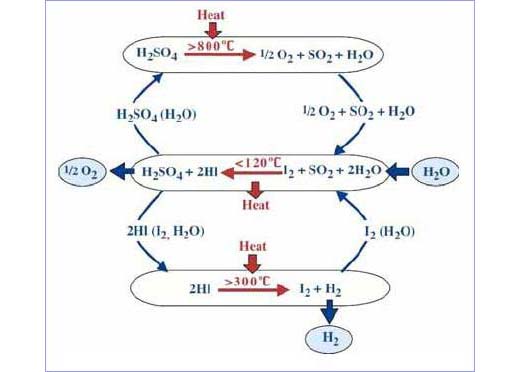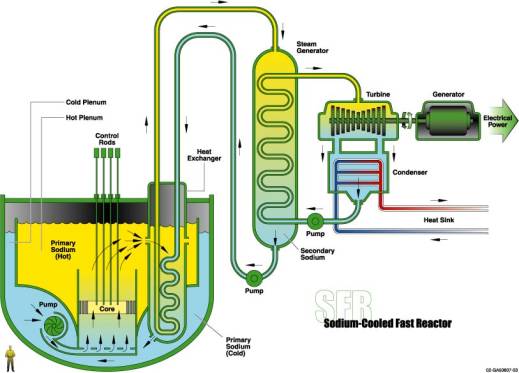
Cursed
unto the third and fourth generation? (Deuteronomy 5:9)
Generation IV International Forum
Ten countries (Argentina, Brazil, Canada, France, Japan,
Korea, RSA, Switzerland. UK and USA) joined together to form the Generation IV
International Forum (GIF) with the objective of developing a successor nuclear
energy system to the previous Generations I and II and to follow Generation III
systems currently under design and construction.
The first UK nuclear reactors of the Magnox type are placed
in category I (One), while the struggling Advanced Gas-Cooled Reactors (AGR) and
the Sizewell B Light Water Reactor (LWR) are classed as category II. The French
Areva Evolutionary Pressure Reactor (EPR) is claimed as a Generation III system,
the prototype being under construction at Olkiluoto in Finland, while a second
is under construction in France. It is expected that a Generation III+ as an
improved version of III will dominate reactor orders up to 2030, after which it
is hoped that Generation IV will be available for international deployment.
In December 2002 the US DOE and GIF published "A
technology roadmap for Generation IV nuclear energy systems" (1) and (4)
which "defines and plans the necessary R&D to support a generation
of innovative nuclear energy systems …". The promoters were right to
go for "systems" because a new generation requires a three-component
system of fuel manufacturing, a reactor and a processing plant working as a
closed cycle.
Second and third generation nuclear power plants operate in
a "once-through" mode. This means that only just over half of the 0.7%
fissionable uranium U-235 content of natural uranium goes into the fuel, while
the majority of the hard-won "heavy metal" (as it is known) ends up in
enrichment "tails" and in spent fuel as waste. The
"once-through" mode is thus characterised by two problems; it requires
a constant and increasing supply of natural uranium (if nuclear power is to
contribute to rising demand for electricity), while the bulk of it adds to the
accumulation of radioactive waste.
As for all minerals, uranium extraction is subject to a
Hubbert curve of increased production until it reaches a peak, followed by a
decline and eventual economic exhaustion. An individual mine exhibits its
Hubbert curve through its productive life, while the aggregate of the production
of all the mines, past, present and future, comprises the global curve.
Apologists for nuclear power point to the universality of uranium in the earth's
crust and in seawater, while ignoring the enormous energy required for its
extraction from these low concentration sources, which would exceed the energy
output of the consequent fission of the fuel which it provides.
So in its quest for the sustainability denied to the "once-through" operational mode the GIF roadmap sets out a route to an extension "… of the fuel supply into future centuries by recycling used fuel to recover its energy content and by converting U-238 (the remaining non-fissionable isotope comprising the main part of natural uranium) to new fuel".
Recycling
If nuclear power is to continue there is an urgent need for fast reactors to be introduced by 2030 as shown in the GIF plot "Worldwide Uranium Resource Utilisation"

The amounts of "Known Resources" shown in the
Utilisation Chart correspond with what is described as "Reasonably Assured
Resources" plus "Inferred Resources" in the IAEA - OECD/NEA
"Red Book" of world uranium reserves, totalling 4.7 million tonnes of
natural uranium while assuming a purchasing price of > US$ 130/kg. Though
prices are currently around US$ 230/kg, primary uranium production is falling,
so that the "Red book" philosophy needs reappraisal. The problem is
that much of the deposits included in the analysis are characterised by low ore
grades, which attenutates the rates of extraction and elevates the costs of the
same.
The "Speculative Resources" shown in the chart correspond in the "Red Book" to "Undiscovered Resources" comprising Prognosticated and Speculative Resources aggregating to the 17 million tonnes indicated. Since the known resources are themselves somewhat speculative and the speculative resources extremely so, the basis of the chart is doubly speculative! However, for the purpose of the following examination the optimistic assumptions of the Roadmap will be assumed.
In the Utilisation Chart the "Known Resources" of 4.7 million tonnes of natural uranium are expected to be exhausted by 2030. Assuming fast reactors are introduced by then, a further 10 million tonnes (twice the "Known Resources") have to be found and production ready from the admittedly "Speculative Resources". If fast reactors are introduced somewhat later in 2050, all the known and speculative resources will have gone by 2070. Without the need for further analysis, the GIF chart clearly shows the fragility of the nuclear "renaissance".
Introducing Generation III and III+ nuclear reactors (LWR Once Through) with an anticipated operational life of 60 years in a "once-through" mode in 2020 would require increasing supplies of natural uranium up until 2080 and beyond. A consequence is that the bulk of the uranium ends up in repositories as waste with the vexed problem of locating suitable storage spaces in the repositories.
Also arising in the spent fuel are transuranics (*)
including plutonium and actinides (*). Heat arises from the decay of
radionuclides, while the spontaneous fission of the minor actinides also
generate some heat – but one of the problems to be resolved in the waste
management processes. Neutron radiation is the major problem, which makes the
spent fuel difficult to manage and poses criticality problems.
For sustainability a number of matching fast breeder
reactors would have to be built in parallel with thermal reactors. This is shown
diagrammatically in the GIF flow chart of "Symbiotic Fuel Cycles"

Ideally from 2020 an equal number of fast reactors to the
thermal ones need to be built. However, the timescale of the R&D determines
that the Generation IV designs will be unlikely to be available before 2030,
though claims of readiness for some are made for 2010-25, while in the interim
from 2010 to 2030 "once-through" Generation III+ types are considered
likely to be deployed.
From the flow chart it is clear that the fast reactor
stream requires the development of suitable fuel fabrication and used fuel
handling facilities (shown as recycling in the right-hand flow), both of which
have to be in place for the fast reactor operation or there will be no suitable
fuel. It is also clear from the flow chart that some of highly radioactive
long-lived transuranic actinides are recovered in the recycling processes and
when added to the fast reactor fuel can be destroyed in the ensuing fission,
alleviating the waste management problem.
The reprocessing and fuel fabrication components of the
fast reactor cycle are potentially hazardous and difficult to manage. R&D
and considerable expenditure is required in this aspect of the Generation IV
Roadmap, perhaps exceeding or at least equalling that devoted to reactor design.
Fast reactors
At this point in the discussion the three roles of a fast
reactor need clarification.
Arising in the spent fuel of a "Once Through"
reactor are transuranic actinides (neptunium, plutonium, americum and curium)
which are created from the neutron capture in the U-238 in the fuel.
Thereafter some of the plutonium is separated out from the
spent fuel in a recycling process and this is used as a component of the fuel
for the fast reactor core. The reaction is "fast" because the neutrons
are not slowed by a moderator and are of a greater intensity than from a low
enriched uranium (LEU) fuel being emitted from plutonium or a highly enriched
uranium (HEU) fuel.
As is evident from the flow chart the initial fast reactor
core charge originates from the recycling of the spent fuel from a "Once
Through" reactor. It is supplemented thereafter by separating out the
plutonium generated in the blanket of U-238 uranium surrounding the fast breeder
reactor core, which is then incorporated in fresh fuel.
The three fast reactor roles depend on their conversion
ratios, which is defined as he amount of new transuranics created divided by the
amount of transuranics consumed each pass through the reactor. A conversion
ratio less than one ("burner" mode) means that there is a net
consumption of transuranics, easing waste management problems. A conversion
ration near to one ("converter" mode) balances transuranic production
and consumption. A conversion ratio greater than one ("breeder" mode)
means that there is net creation of transuranics. (5)
The fast reactor in breeder role is cited as the provider
of the ultimate nuclear sustainability, but then an even greater quantity of
transuranics are created exacerbating the waste management problem. The
highly-radioactive transuranics created in the surrounding U-238
"blanket" have to be separated out and sent to the fuel fabrication
plant to make the next round of plutonium-based fuel – a most unpleasant
business! If the burner role is adopted, the waste problem is alleviated but
there is no sustainability, nevertheless it appears that for the moment the
burner role is to prevail.
A bunch of six
The Generation IV energy systems comprise six types of
reactor, three of which are thermal and three are fast. This makes the team's
task of reviewing and comparing them immensely complex, so tables of
"cross-cutting" developments have been constructed so that findings
for one reactor may be applicable to others. However, it appears that two of the
six are emerging as the likely candidates, the very-high-temperature gas-cooled
thermal reactor able to be used for coal gasification and thermochemical
hydrogen production (VHTR) and the sodium-cooled fast reactor system (SFR). This
is confirmed by a US government web page (2) published in January 2007.
The US government is funding much of
the R&D, so it is unsurprising that a reactor with the potential to
produce hydrogen has been selected. To allow its citizens to retain their
customary mobility, the creation of a hydrogen economy is seen as the solution
to the depletion of oil reserves and its derivative, gasoline (petrol). There
are currently two ways of producing hydrogen, electrolysis using electricity
most likely generated by the combustion of coal or gas and the steam reforming
of natural gas, both of which result in carbon emissions and deplete fossil
fuels. The very-high-temperature reactor is linked with a thermochemical process
from which hydrogen is produced and which needs the high-temperature feature.
(3)
The US government statement in regard to the selection of
the sodium-cooled fast reactor (SFR) describes its mission as "the
management of high-level wastes and in particular management of plutonium and
other actinides". It is a "burner", not a breeder in which
plutonium fuel creates further plutonium in a surrounding "blanket" of
uranium U-238 and in which it is envisaged there is a gain in the plutonium in
the blanket over the plutonium consumed in the reaction, with a
"doubling" time of 15 to 20 years. As supplies of natural uranium
decline, it is supplanted by a plutonium-based fuel which is incrementally
augmented by fresh plutonium in a repetitive cycle, providing claims of
sustainability – as a new form of "perpetual motion".
The selection of the SFR burner is of particular
significance for the management of nuclear waste in the US where reprocessing
was banned and where spent fuel is held in ponds for a number of years before
transfer to "dry casks" and ultimately to an underground repository.
If some of the residual plutonium and other actinides in the waste can be
destroyed the problems would be somewhat reduced.
Referring back to the GIF chart "Worldwide Uranium
Resource Utilisation" the sustainability of nuclear power depends on some
of the speculative uranium resources maturing as production together with the
parallel development of fast breeder systems allowing the creation of a
"steady state" operational mode in which no new natural uranium is
needed. In the Generation IV Roadmap (1) the only references to a "breeder
reactor" occur in the list of acronyms, which is a puzzling omission given
that it is claimed to be the key to sustainability. However, the sodium-cooled
fast reactor is to have a "closed fuel cycle" requiring recycling so
that the transuranics can be incorporated in its fuel, which will relieve the
supply situation to a certain degree.
The VHTR
The very-high temperature gas-cooled thermal reactor (VHTR
aka NGNP) will have a coolant system outlet temperature of at ca. 1000°C. The
reactor core of low enriched fuel is contained and moderated in graphite. Helium
gas is circulated through a heat exchanger, which in turn provides the heat for
a hydrogen production plant.

Graphite is chosen for the core is because it can withstand
up to 1600°C based on experience with space shuttle re-entry cladding. No
mention in any of the documents uncovered refers to problems arising from
irradiation, characterised by the Wigner Effect in which energy is stored in it,
nor of its progressive disintegration by neutron bombardment. The high
temperature working may well continuously "anneal" the Wigner energy
out, but increase its friability. In 1956 it was attempts to "anneal"
the Wigner energy in Pile 1 at Windscale (now Sellafield in the UK) which caused
a fire and melted fuel elements. A graphite fire was also a factor in the
Chernobyl incident.
The current advanced gas-cooled reactors in the UK are
suffering from moderator block disintegration and some are attempting to run at
a low operational level to squeeze a little more life out of them. The selection
of graphite based on the short-term experience of re-entry belies the long term
effects of high temperature and irradiation on it. The fuel may be
"pebbles" shrouded in graphite, which have to remain intact so that
new ones can be dropped in and the old ones let out. If some of the pebbles
disintegrate, the fuel channels may block with debris and prevent reloading of
the core.
The reason for the very high temperature is that more than
800°C is needed for a novel process to produce hydrogen using sulphuric acid
and iodine. The iodine process for hydrogen production is complex and requires
the use of exotic materials to contain it - tantalum and tungsten are mentioned.
The process is complex and may well be unstable and the product may contain
iodine as the distillation to separate it from the hydrogen may not be too
efficient.

Since the need for the very-high-temperature gas-cooled
reactor is defined by the temperature
needed for this complex thermo-chemical process, it would be advisable to
ascertain the viability of it before engaging in the development of such a
problematic reactor. The losses and overall yield of the process and the energy
costs of the input chemicals need pre-evaluation as well as the energy balance
of the overall process, which may not give an advantage over simple electrolytic
decomposition of water.
The SFR
The sodium-cooled fast reactor is the other type selected
from the six candidates for further development. The fuel cycle employs full
actinide recycle supported by reprocessing and uses a mixed fuel of plutonium,
uranium and actinides.

This is essentially a burner reactor with the advantage
that it can reduce waste management problems by consuming plutonium and
long-life highly radioactive actinides while generating electricity.
Materials of construction
Oak Ridge Laboratory
has been given the task of developing and specifying the materials of
construction (6) and (7). The spokesman states "We understand that a
limiting factor for these reactors will be the materials used in their
operation. Reactor materials will be exposed to very high temperatures, intense
neutron radiation, and corrosive environments—in many cases, all three at once."
The use of graphite and carbon composites is under
consideration, as is the potential fire risk if air enters the system and
displaces the helium gas. The likely metal components contain nickel, chromium,
molybdenum, vanadium and tungsten, all of which are increasingly in demand and
expensive. Alloy steels are embrittled when subjected to irradiation and metal
fatigue has to be considered. The other factor is the extreme weakness of
stainless steels when subjected to high temperature.
The most telling statement refers to the operational life
of the materials, which are now required to survive for 60 years. Other than
subjecting them to the intensive working conditions for their anticipated
operational life, there is no guarantee that they will provide the necessary
security and containment.
Commentary
The aspirations of the nuclear alchemists of continuing
supplies of nuclear electricity for hundreds of years have been subjugated by
the political necessities of preserving mobility (9) and mollifying concerns
about long-term radioactive waste (8). Neither of the two types of reactor
selected for development and honoured with substantial US government finance
provide for the progressive breeding of fast reactor fuel needed to replace the
dwindling supplies of extractable natural uranium.
Even with the deployment of successful fast breeder
reactors the doubling time of 15 to 20 years means that supplies of natural
uranium have to be maintained for decades if not centuries until the fleet of
"once-through" reactors can be progressively replaced.
Panic will soon set in (if it has not already) as oil, gas,
coal and natural uranium pass or approach their "peak" production
destinies. So perhaps a detached observer would excuse this costly and
inevitably fruitless search for the "holy grail" of the nuclear
optimists.
John Busby 13 September 2007
(1) https://gif.inel.gov/roadmap/pdfs/gen_iv_roadmap.pdf
(2) https://nuclear.energy.gov/pdfFiles/factSheets/NGNP-GENIV-Final-Jan31-07.pdf
(3) https://www.nuclear.utah.edu/Nep/CVEEN5730/pdf%20files/SI%20Cycle.pdf
(4) https://www.ne.doe.gov/pdfFiles/Gen-IV_Implementation_Plan_9-9-03.pdf
(5) https://www.ne.doe.gov/pdfFiles/genIvFastReactorRptToCongressDec2006.pdf
(6) https://www.ornl.gov/info/ornlreview/v37_1_04/article_02.shtml
(7) https://nuclear.inl.gov/deliverables/docs/intg-matls-plan.pdf
(8) https://www.nuc.berkeley.edu/ans/norcal/presentations/ans-3-16-06.pdf
(9) https://www.tbp.org/pages/publications/bent/features/sp04uhrig.pdf
* Transuranic (or transuranium) elements are the chemical elements with atomic numbers greater than that of uranium, 92. Those now found on earth are artificially generated via nuclear reactors or particle accelerators. The half-lives of these elements show a trend of decreasing with atomic number, whereby the radioactivity increases. The subsequent four elements to uranium are neptunium (93), plutonium (94), americum (95) and curium (96). The range of 15 elements known as the actinides overlap the transuranics, ranging from atomic numbers 89 to 103. The latter half of the series possess very short half-lives.